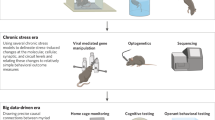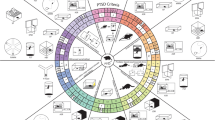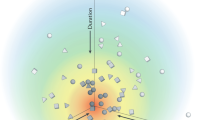Abstract
In our ongoing efforts to advance understanding of human diseases, translational research across rodents and humans on stress-related mental disorders stands out as a field that is producing discoveries that illuminate mechanisms of risk and pathophysiology at a brisk rate. Here we offer a Perspective on how a productive translational research dialog between preclinical models and clinical studies of these disorders is being powered by an ever-developing appreciation of the shared neural circuits and genetic architecture that moderate the response to stress across species. Working from these deep foundations, we discuss the approaches, both traditional and innovative, that have the potential to deliver a new generation of risk biomarkers and therapeutic strategies for stress-related disorders.
This is a preview of subscription content, access via your institution
Access options
Subscribe to this journal
Receive 12 print issues and online access
$209.00 per year
only $17.42 per issue
Buy this article
- Purchase on Springer Link
- Instant access to full article PDF
Prices may be subject to local taxes which are calculated during checkout

Marina Corral Spence/Nature Publishing Group

Marina Corral Spence/Nature Publishing Group

Similar content being viewed by others
References
Roozendaal, B., McEwen, B.S. & Chattarji, S. Stress, memory and the amygdala. Nat. Rev. Neurosci. 10, 423–433 (2009).
American Psychiatric Association. Diagnostic and Statistical Manual of Mental Disorders edn. 5 (APA Press, Washington, DC, 2013).
Kessler, R.C. et al. The global burden of mental disorders: an update from the WHO World Mental Health (WMH) surveys. Epidemiol. Psychiatr. Soc. 18, 23–33 (2009).
Selye, H. A syndrome produced by diverse nocuous agents. Nature 138, 32 (1936).
Szabo, S., Tache, Y. & Somogyi, A. The legacy of Hans Selye and the origins of stress research: a retrospective 75 years after his landmark brief “letter” to the editor of Nature. Stress 15, 472–478 (2012).
McEwen, B.S. Protective and damaging effects of stress mediators: central role of the brain. Dialogues Clin. Neurosci. 8, 367–381 (2006).
de Kloet, E.R., Joels, M. & Holsboer, F. Stress and the brain: from adaptation to disease. Nat. Rev. Neurosci. 6, 463–475 (2005).
Tovote, P., Fadok, J.P. & Luthi, A. Neuronal circuits for fear and anxiety. Nat. Rev. Neurosci. 16, 317–331 (2015).
Maren, S. & Holmes, A. Stress and fear extinction. Neuropsychopharmacology doi:10.1038/npp.2015.180 (2015).
Maren, S. & Quirk, G.J. Neuronal signalling of fear memory. Nat. Rev. Neurosci. 5, 844–852 (2004).
Janak, P.H. & Tye, K.M. From circuits to behaviour in the amygdala. Nature 517, 284–292 (2015).
Knigge, K.M. Adrenocortical response to stress in rats with lesions in hippocampus and amygdala. Proc. Soc. Exp. Biol. Med. 108, 18–21 (1961).
Gray, T.S., Carney, M.E. & Magnuson, D.J. Direct projections from the central amygdaloid nucleus to the hypothalamic paraventricular nucleus: possible role in stress-induced adrenocorticotropin release. Neuroendocrinology 50, 433–446 (1989).
Blanchard, D.C. & Blanchard, R.J. Innate and conditioned reactions to threat in rats with amygdaloid lesions. J. Comp. Physiol. Psychol. 81, 281–290 (1972).
LeDoux, J.E. Emotion circuits in the brain. Annu. Rev. Neurosci. 23, 155–184 (2000).
Pape, H.C. & Pare, D. Plastic synaptic networks of the amygdala for the acquisition, expression, and extinction of conditioned fear. Physiol. Rev. 90, 419–463 (2010).
Bouton, M.E. Context, ambiguity, and unlearning: sources of relapse after behavioral extinction. Biol. Psychiatry 52, 976–986 (2002).
Fanselow, M.S. & Poulos, A.M. The neuroscience of mammalian associative learning. Annu. Rev. Psychol. 56, 207–234 (2005).
Herman, J.P., Ostrander, M.M., Mueller, N.K. & Figueiredo, H. Limbic system mechanisms of stress regulation: hypothalamo-pituitary-adrenocortical axis. Prog. Neuropsychopharmacol. Biol. Psychiatry 29, 1201–1213 (2005).
Frankland, P.W. & Bontempi, B. The organization of recent and remote memories. Nat. Rev. Neurosci. 6, 119–130 (2005).
Milad, M.R. & Quirk, G.J. Fear extinction as a model for translational neuroscience: ten years of progress. Annu. Rev. Psychol. 63, 129–151 (2012).
Fitzgerald, P.J. et al. Durable fear memories require PSD-95. Mol. Psychiatry 20, 901–912 (2015).
Goshen, I. et al. Dynamics of retrieval strategies for remote memories. Cell 147, 678–689 (2011).
Do-Monte, F.H., Quinones-Laracuente, K. & Quirk, G.J. A temporal shift in the circuits mediating retrieval of fear memory. Nature 519, 460–463 (2015).
Singewald, N., Schmuckermair, C., Whittle, N., Holmes, A. & Ressler, K.J. Pharmacology of cognitive enhancers for exposure-based therapy of fear, anxiety and trauma-related disorders. Pharmacol. Ther. 149, 150–190 (2015).
Cryan, J.F. & Holmes, A. The ascent of mouse: advances in modelling human depression and anxiety. Nat. Rev. Drug Discov. 4, 775–790 (2005).
LaBar, K.S., LeDoux, J.E., Spencer, D.D. & Phelps, E.A. Impaired fear conditioning following unilateral temporal lobectomy in humans. J. Neurosci. 15, 6846–6855 (1995).
Furmark, T., Fischer, H., Wik, G., Larsson, M. & Fredrikson, M. The amygdala and individual differences in human fear conditioning. Neuroreport 8, 3957–3960 (1997).
Bremner, J.D. et al. Positron emission tomographic imaging of neural correlates of a fear acquisition and extinction paradigm in women with childhood sexual-abuse-related post-traumatic stress disorder. Psychol. Med. 35, 791–806 (2005).
Pitman, R.K. et al. Biological studies of post-traumatic stress disorder. Nat. Rev. Neurosci. 13, 769–787 (2012).
Milad, M.R. et al. Neurobiological basis of failure to recall extinction memory in posttraumatic stress disorder. Biol. Psychiatry 66, 1075–1082 (2009).
Likhtik, E. & Paz, R. Amygdala-prefrontal interactions in (mal)adaptive learning. Trends Neurosci. 38, 158–166 (2015).
Alvarez, R.P., Biggs, A., Chen, G., Pine, D.S. & Grillon, C. Contextual fear conditioning in humans: cortical-hippocampal and amygdala contributions. J. Neurosci. 28, 6211–6219 (2008).
Delgado, M.R., Nearing, K.I., Ledoux, J.E. & Phelps, E.A. Neural circuitry underlying the regulation of conditioned fear and its relation to extinction. Neuron 59, 829–838 (2008).
VanElzakker, M.B., Kathryn Dahlgren, M., Caroline Davis, F., Dubois, S. & Shin, L.M. From Pavlov to PTSD: the extinction of conditioned fear in rodents, humans, and in anxiety disorders. Neurobiol. Learn. Mem. 113, 3–18 (2014).
Linnman, C., Zeffiro, T.A., Pitman, R.K. & Milad, M.R. An fMRI study of unconditioned responses in post-traumatic stress disorder. Biol. Mood Anxiety Disord. 1, 8 (2011).
Whittle, N., Hauschild, M., Lubec, G., Holmes, A. & Singewald, N. Rescue of impaired fear extinction and normalization of cortico-amygdala circuit dysfunction in a genetic mouse model by dietary zinc restriction. J. Neurosci. 30, 13586–13596 (2010).
Andero, R. & Ressler, K.J. Fear extinction and BDNF: translating animal models of PTSD to the clinic. Genes Brain Behav. 11, 503–512 (2012).
Casey, B.J. et al. Brain-derived neurotrophic factor as a model system for examining gene by environment interactions across development. Neuroscience 164, 108–120 (2009).
Holmes, A. Genetic variation in cortico-amygdala serotonin function and risk for stress-related disease. Neurosci. Biobehav. Rev. 32, 1293–1314 (2008).
Caspi, A., Hariri, A.R., Holmes, A., Uher, R. & Moffitt, T.E. Genetic sensitivity to the environment: the case of the serotonin transporter gene and its implications for studying complex diseases and traits. Am. J. Psychiatry 167, 509–527 (2010).
Holmes, A., Murphy, D.L. & Crawley, J.N. Abnormal behavioral phenotypes of serotonin transporter knockout mice: parallels with human anxiety and depression. Biol. Psychiatry 54, 953–959 (2003).
Kalueff, A.V., Olivier, J.D., Nonkes, L.J. & Homberg, J.R. Conserved role for the serotonin transporter gene in rat and mouse neurobehavioral endophenotypes. Neurosci. Biobehav. Rev. 34, 373–386 (2010).
Hariri, A.R. & Holmes, A. Genetics of emotional regulation: the role of the serotonin transporter in neural function. Trends Cogn. Sci. 10, 182–191 (2006).
Neumeister, A. et al. Elevated brain cannabinoid CB1 receptor availability in post-traumatic stress disorder: a positron emission tomography study. Mol. Psychiatry 18, 1034–1040 (2013).
Hirvonen, J. et al. Reduced cannabinoid CB1 receptor binding in alcohol dependence measured with positron emission tomography. Mol. Psychiatry 18, 916–921 (2013).
Hill, M.N. et al. Reductions in circulating endocannabinoid levels in individuals with post-traumatic stress disorder following exposure to the World Trade Center attacks. Psychoneuroendocrinology 38, 2952–2961 (2013).
Gaetani, S., Cuomo, V. & Piomelli, D. Anandamide hydrolysis: a new target for anti-anxiety drugs? Trends Mol. Med. 9, 474–478 (2003).
Dincheva, I. FAAH genetic variation enhances fronto-amygdala function in mouse and human. Nat. Comm. 6, 6395 (2015).
Hariri, A.R. et al. Divergent effects of genetic variation in endocannabinoid signaling on human threat- and reward-related brain function. Biol. Psychiatry 66, 9–16 (2009).
Gunduz-Cinar, O. et al. Convergent translational evidence of a role for anandamide in amygdala-mediated fear extinction, threat processing and stress-reactivity. Mol. Psychiatry 18, 813–823 (2013).
Gunduz-Cinar, O., Hill, M.N., McEwen, B.S. & Holmes, A. Amygdala FAAH and anandamide: mediating protection and recovery from stress. Trends Pharmacol. Sci. 34, 637–644 (2013).
Binder, E.B. et al. Association of FKBP5 polymorphisms and childhood abuse with risk of posttraumatic stress disorder symptoms in adults. J. Am. Med. Assoc. 299, 1291–1305 (2008).
White, M.G. et al. FKBP5 and emotional neglect interact to predict individual differences in amygdala reactivity. Genes Brain Behav. 11, 869–878 (2012).
Zannas, A.S. & Binder, E.B. Gene-environment interactions at the FKBP5 locus: sensitive periods, mechanisms and pleiotropism. Genes Brain Behav. 13, 25–37 (2014).
Admon, R., Milad, M.R. & Hendler, T. A causal model of post-traumatic stress disorder: disentangling predisposed from acquired neural abnormalities. Trends Cogn. Sci. 17, 337–347 (2013).
McLaughlin, K.A. et al. Amygdala response to negative stimuli predicts PTSD symptom onset following a terrorist attack. Depress. Anxiety 31, 834–842 (2014).
Swartz, J.R., Knodt, A.R., Radtke, S.R. & Hariri, A.R. A neural biomarker of psychological vulnerability to future life stress. Neuron 85, 505–511 (2015).
Yang, R.J. et al. Variation in mouse basolateral amygdala volume is associated with differences in stress reactivity and fear learning. Neuropsychopharmacology 33, 2595–2604 (2008).
Morey, R.A. et al. Amygdala volume changes in posttraumatic stress disorder in a large case-controlled veterans group. Arch. Gen. Psychiatry 69, 1169–1178 (2012).
Griebel, G. & Holmes, A. 50 years of hurdles and hope in anxiolytic drug discovery. Nat. Rev. Drug Discov. 12, 667–687 (2013).
Monfils, M.H., Cowansage, K.K., Klann, E. & LeDoux, J.E. Extinction-reconsolidation boundaries: key to persistent attenuation of fear memories. Science 324, 951–955 (2009).
Schiller, D. et al. Preventing the return of fear in humans using reconsolidation update mechanisms. Nature 463, 49–53 (2010).
Agren, T. et al. Disruption of reconsolidation erases a fear memory trace in the human amygdala. Science 337, 1550–1552 (2012).
Marin, M.F., Camprodon, J.A., Dougherty, D.D. & Milad, M.R. Device-based brain stimulation to augment fear extinction: implications for PTSD treatment and beyond. Depress. Anxiety 31, 269–278 (2014).
Osuch, E.A. et al. Repetitive TMS combined with exposure therapy for PTSD: a preliminary study. J. Anxiety Disord. 23, 54–59 (2009).
Brunoni, A.R. et al. The sertraline vs. electrical current therapy for treating depression clinical study: results from a factorial, randomized, controlled trial. JAMA Psychiatry 70, 383–391 (2013).
Holtzheimer, P.E. & Mayberg, H.S. Deep brain stimulation for psychiatric disorders. Annu. Rev. Neurosci. 34, 289–307 (2011).
Lozano, A.M. et al. A multicenter pilot study of subcallosal cingulate area deep brain stimulation for treatment-resistant depression. J. Neurosurg. 116, 315–322 (2012).
Insel, T. et al. Research domain criteria (RDoC): toward a new classification framework for research on mental disorders. Am. J. Psychiatry 167, 748–751 (2010).
Acknowledgements
A.R.H. is supported by Duke University and by US National Institutes of Health grants R01DA033369 and R01AG049789. A.H. is supported by the National Institute on Alcohol Abuse and Alcoholism Intramural Research Program, the Henry Jackson Foundation for the Advancement of Military Medicine, and the Department of Defense in the Center for Neuroscience and Regenerative Medicine.
Author information
Authors and Affiliations
Corresponding author
Ethics declarations
Competing interests
The authors declare no competing financial interests.
Rights and permissions
About this article
Cite this article
Hariri, A., Holmes, A. Finding translation in stress research. Nat Neurosci 18, 1347–1352 (2015). https://doi.org/10.1038/nn.4111
Received:
Accepted:
Published:
Issue Date:
DOI: https://doi.org/10.1038/nn.4111
This article is cited by
-
Fear extinction rescuing effects of dopamine and L-DOPA in the ventromedial prefrontal cortex
Translational Psychiatry (2024)
-
Perineuronal Nets Alterations Contribute to Stress-Induced Anxiety-Like Behavior
Molecular Neurobiology (2024)
-
Medial prefrontal cortex input to basolateral amygdala controls acute stress-induced short-term anxiety-like behavior in mice
Neuropsychopharmacology (2023)
-
Real-world stress resilience is associated with the responsivity of the locus coeruleus
Nature Communications (2021)
-
Biological clues to an enigmatic treatment for traumatic stress
Nature (2019)



